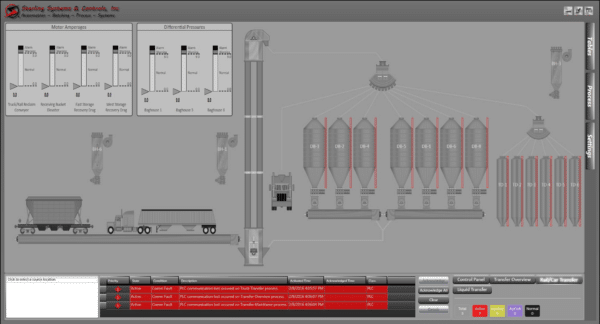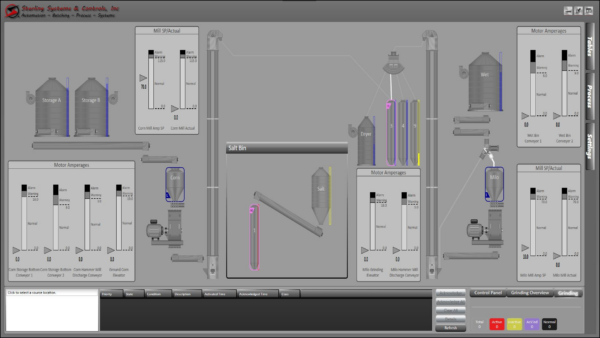Grain Terminal Control System
An example of a grain terminal control system will utilize rack mounted PC’s running Sterling Systems customized Windows-based automation software using a SQL express database. The PC’s are connected to an Allen Bradley PLC. The PLC provides I/O interface to field devices. Any manual controls are done within the Sterling Systems customized grain terminal control system software. All components used are non-proprietary and available from local suppliers.
The PC is connected to the grain terminal control system PLC via Ethernet. Weight indicators supplied are mounted in the control panel and communicate using Ethernet as well. The PLC conducts batching and weighing functions as required. The customized software system includes a material Receiving / Transfer application and a Grinding application. Each grain terminal control system is different, so a custom-engineered approach is required. In this situation, the following equipment was included in the control list within the automation system:
- Top Conveyors 1, 2 and 3
- Top Conveyor Gates
- Electric Gates under all Bins
- Total of Sixteen (16) 30HP Grain Bin Blowers
- Grain Bin Reclaim Conveyors (4)
- Grain Bin Sweep Augers
- Two (2) Main Feed Legs
- Dual Distributors
- Loadout Distributors
- Tripper Wench
- Flat Commodity Storage Conveyor Plug and Motion Switches
- Flat Commodity Garage Door Openers (4)
- Switches for Reclaim and Loadout Jump Legs
- Grain Bin 2HP Exhaust Motors (32 Total)
- Three (3) Hammermills
- Two (2) Hammermill Drag Conveyors
- Air Compressor
- Two (2) Rail Reclaim Conveyors
- Two (2) Dump Reclaim Conveyors

Typical Grain Transfer
Example: Any grain transfer is first initiated by selecting the source and destination locations. After the source and destination are selected, the operator clicks on the control panel and presses Start. This starts the equipment automatically. Selecting the specific transfer that is currently running and then pressing the Stop button will sequentially shut down the selected running process and equipment. By pressing the Abort button this can either immediately shut down the running process or all processes without a sequential shutdown.
A graphical screen in the grain terminal control system will display the transfer process. Status messages, alarms, and functions of the process are displayed. The equipment shown is representative of the equipment controlled. The screens are very dynamic in that all the equipment shown changes shades to identify the various status conditions. Each alarm condition is logged.

Typical Grinding Process Screen
This grain terminal includes a grinding process. The grinding screen shows the roller mills and surrounding equipment. When the equipment or vessel is on, or active, the graphic will go from dark grey to bright white. If an alarm exists on any equipment, a red square surrounds the device with a pulsating red triangle. Each ingredient bin for the batching system included in this grain terminal shows the calculated level as a narrow bar graph, and they are color-coded as well. The color is determined by the material level setpoints and bin inventory in the Bin Assignment table. The bar graph will be blue if the material level is above the warning setpoint, yellow if between the warning and low setpoint, and red if below the low setpoint.
No matter what the grain terminal consists of or requires, Sterling Systems & Controls can custom engineer your control system solution to increase productivity and profitability.